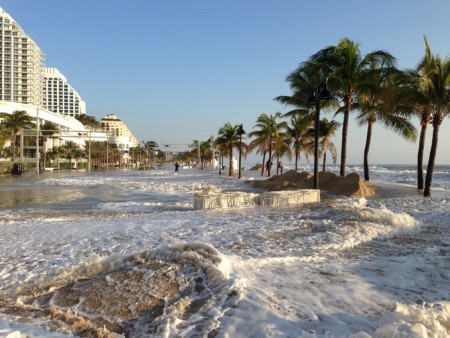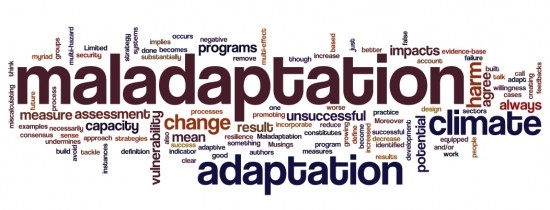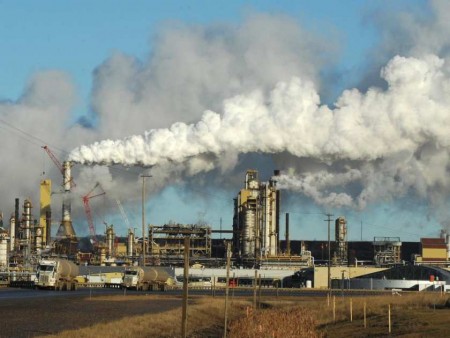August 16, 2015 – When my wife and I were in Florida last winter we drove along A1A, the roadway next to the Atlantic Ocean, where the City of Fort Lauderdale was in the process of spending $11.8 million to mitigate against future hurricanes and “storms of the century” tidal surges. The project involved creating a wave wall and new drainage. Even during construction, a seasonal higher-than-expected tide breached the sea wall. This is what we call a maladaptation strategy.
Maladaptation is always being one step behind appropriate adaptation and mitigation. It happens because infrastructure investments get planned, funded and built based on obsolete data. City planners react to an incident, collect data, then design a solution and get it built with safety thresholds that are no longer a reflection of new realities.
Humans are good at maladaptation, which is a bad thing.
We exhibit it in our daily lives….not fixing a leaking window until a rainstorm causes a damaging flood. And we are led by politicians who exhibit maladaptive behavior in many ways. If they promote, approve and fund a project, it often only addresses the present and not the future vulnerability.
Our failure is one of timing.
Cities, states and nations build infrastructure that meets the past and present but seldom the future. And when the future is not measured in decades, but centuries, maladaptation becomes almost a certainty. If we were better long-term planners, we could see the consequences of our current behavior and develop adaptation strategies that work. That is the real challenge we face with climate change. Climate change is creeping up on us and “storms of the century” events are now becoming “storms of the decade.” We can create a mitigation strategy for a decade, but what about five decades from now or a century?
In a June 2015 report entitled (Re)conceptualising maladaptation in policy and practice: towards an evaluative framework, the authors provide the findings of a five-year, multi-country research project looking at climate resilience in semi-arid regions of our planet. The report defines adaptation and looks at five ways in which our response constitutes maladaptation. Where adaptation refers to a process of adjustment to actual or expected changes, maladaptation refers to how we get adaptation wrong.
The authors describe the reasons for maladaptation:
- Non-action related to climate risk on the part of government players.
- Strategies that choose to ignore climate change risk as a primary focus.
- The lack of understanding of performance in a climate risk intervention project measured against time.
- Not recognizing shifting complexities in the ecosystem and the economy for those in the affected area, where climate change mitigation has been implemented.
- Not recognizing how an adaptation strategy impacts all social strata within a population.
But all is not lost.
The authors of the report describe a framework for adaptation to avoid maladaptation. They include warning signs and symptoms to heed before money is misspent.
Let’s look at two examples. The first is our Fort Lauderdale shoreline and roadway project.
The city government chose an adaptation strategy that clearly will lead to maladaptation. How so?
Illustrations of points #2 and #3 above, the money is not exclusively being used to increase stormwater runoff capacity and the raising of a berm and wall to mitigate flooding from storm surges. Instead, a portion of the project fund has been spent on new bike lanes, a beachfront promenade, pedestrian lighting, crosswalks, median islands and left turn lanes. To call the strategy maladaptive is to be kind. More like stupid.
Our second example is Canada’s oil sands.
To meet a 30% reduction in carbon emissions as Canada’s national government has pledged to do by 2030, there must be reductions in the amount of CO2 coming from all sectors of the economy. Yet the current Canadian government has chosen to exempt the oil sands in its emission reduction strategy, adopting the non-action of point #1. Instead, it intends to purchase carbon credits on world markets to offset oil sands emission output, which effectively is choosing the strategy of point #2. On the surface one may consider this not to be maladaptive, but in fact, what the government is doing is choosing to kick the oil sands can down the road to some unspecified future date. In Canada’s current federal election campaign, none of the three leading political parties have had the guts to state the obvious, although one candidate expressed it briefly before being corrected, that the appropriate adaptation strategy would be to keep the oil in the ground to meet carbon reduction targets. Canadian and foreign energy companies operating in Canada have exhibited similar maladaptive behaviors in shuttering carbon sequestration projects that could help them offset oil sands output. The net result….instead of a decline in greenhouse gas emissions, the oil sands have increased their net carbon contribution.
Discounting the future is the single largest problem humanity faces addressing climate change.
We, as a global society, are susceptible to political leaders whose timelines are determined by election cycles, and who would prefer more study than action. In their defense, sometimes more study is required to produce the right combination of strategies and projects to address future climate change impacts. But the politicos who deliberately and wantonly confuse the public about the scientific certainty of climate change are guilty of non-action, the point #1 maladaptation risk. Counterfactual behavior of this type can be described as criminal.
When Hurricane Katrina struck Louisiana and inundated New Orleans, leading to the deaths of 1,836 people, maladaptation was the primary cause. Building a city, New Orleans, on land below sea level, situated on a flood plain near the mouth of the Mississippi River, can only be described as a pursuit of maladaptive behavior.
You are asking for it.
Engineers, knowing the vulnerability of the city to flooding, built levees and flood protection systems to address a “storm of the century.” Post-Katrina investigation showed that of the more than 500 kilometers (350 miles) of levees designed to protect the city, most did not fail. So kudos to the engineers.
But a system is only as good as its weakest link and there were a number of those. Some levees were constructed using substandard porous materials. In one case, a levee was re-purposed to serve as a transportation corridor for rail with an extra layer of porous gravel added to its top.
A greater failure was not recognizing the severity of a storm defined as a Category 3 hurricane.
And finally, the biggest maladaptation was a lack of multiple lines of redundant flood defense structure but instead relying on what turned out to be numerous single points of failure.
Returning to the issue of time.
The misjudgement of time is the most critical maladaptive behavior we humans exhibit. We make short-term decisions and investments rather than going long-term. Hence we don’t build for redundancy with a century or multi-century ahead outlook.
This partial list of maladaptation symptoms is a condition of humanity that we need to overcome:
- not learning from our mistakes because we don’t continuously gather data to help avoid bad decision making in the future.
- acting in a risk-averse way so that we are inhibited about making long-term adaptation strategy decisions.
- inhibiting innovation as a means to address adaptation strategies.
- promoting incremental adaptation over massive transformation when the latter is a must need.











